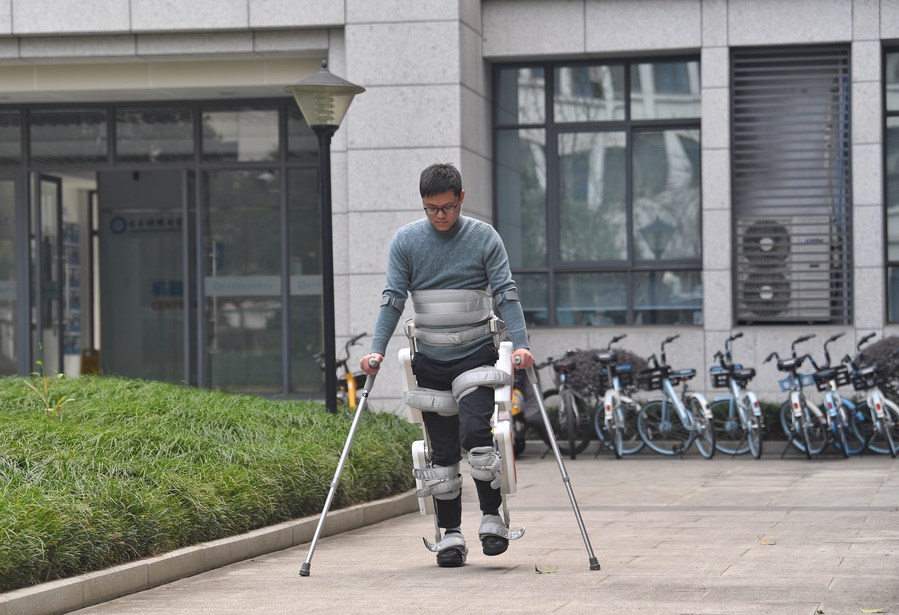Robotic exoskeletons expand options for paraplegic patients

A paraplegic walks with the help of an exoskeleton robot developed by the Robotics Research Center at University of Electronic Science and Technology of China (UESTC) in Chengdu, southwest China's Sichuan Province, March 6, 2023. (Xinhua/Liu Kun)
CHENGDU, March 29 (Xinhua) -- Lin Han, 34, put the robot exoskeleton on a stool and eased himself into it, securing his feet, legs and waist with straps. Grasping the special crutches and pressing the buttons on them, he was slowly raised into a standing position.
He is one of several people in China making use of modern robot technology to give them mobility -- and a new lease on life -- following serious illness or injury.
Lin has suffered from paraplegia for nearly a decade, after he fell from the fourth floor at work, seriously injuring his spine and losing all sensation below the navel. The accident brought him tremendous pain, both physically and mentally, until he was introduced to a wearable robotic exoskeleton.
Once he has the exoskeleton on, with a click of a button, he can stand up, walk and even take a stroll around the neighborhood.
"In addition to providing walking assistance, it's also very helpful in rehabilitation training," said Lin, adding that he now takes an hour-long walk every morning and afternoon, which helps prevent muscle atrophy. "My whole body is getting stronger," he said.
Research and development (R&D) on the robotic exoskeleton began in 2010 at the University of Electronic Science and Technology of China.
In August 2015, the team brought the robotic suits to a rehabilitation center in Chengdu, capital of southwest China's Sichuan Province, looking for volunteers to try them out. Lin, who was receiving treatment there, was reluctant to give it a try.
"We were all very frightened. Those who have been injured have psychological scars, and we dread falling again," recalled Lin.
The team offered meticulous instructions to help him get used to the fancy new suits. He worked hard and gradually gained confidence in using the apparatus safely.
Lin says the exoskeleton has enabled him to wave goodbye to the old days, in which he faced a range of problems including urinary incontinence.
"Now I can control my bladder and I've gradually regained sensations below the belly button," Lin said. "My self-confidence was also back."
In November 2020, Lin tied the knot. Now he is the happy father of two children.
"We continue to improve and make breakthroughs in human-computer interaction, materials and artificial intelligence algorithms, so that disabled people can use exoskeleton robots more comfortably," said Cheng Hong, head of the R&D team.
According to Cheng, more than a hundred exoskeleton robots independently developed by the team have been applied in hospitals in Chengdu, Wuhan and Kunming, to help people with disabilities walk, resume exercise and embrace a better life.
Lin has also taken part in the upgrading of the equipment. The latest version, for instance, is able to assist patients in walking up and down the stairs.
"I've witnessed the transformation of the robotic exoskeleton over the years," he added.
"One of the 'dark technologies' currently being tackled is brain-computer interaction," noted Wang Yawei, a team member.
An EEG Cap with a brain-computer interface is placed on the wearer's head to collect electrical signals. The robotic exoskeleton can read these signals to determine the wearer's intentions and then act accordingly. This brings great hope for some paraplegic patients who are unable to move at all, Wang further explained.
Lin has tried the computer-brain interface technology, and his first impressions are promising.
"It's still at the research stage, and I feel that when I wear it, it's more accurate when I'm in an open space with no external distractions, so that I can concentrate," he said.
"I believe that, with the continuous improvement in key technologies by the scientific research team, our life will become more and more convenient," he added.
Photos
Related Stories
- Robotaxis in Beijing open new chapter of intelligent transport
- Chinese doctors complete robot-assisted coronary angiography
- Paraplegic tries exoskeleton robot for rehabilitation training in SW China
- Robots of every description empower various industries in China
- Chinese scientists develop sea cucumber-inspired shape-shifting robot
Copyright © 2023 People's Daily Online. All Rights Reserved.









